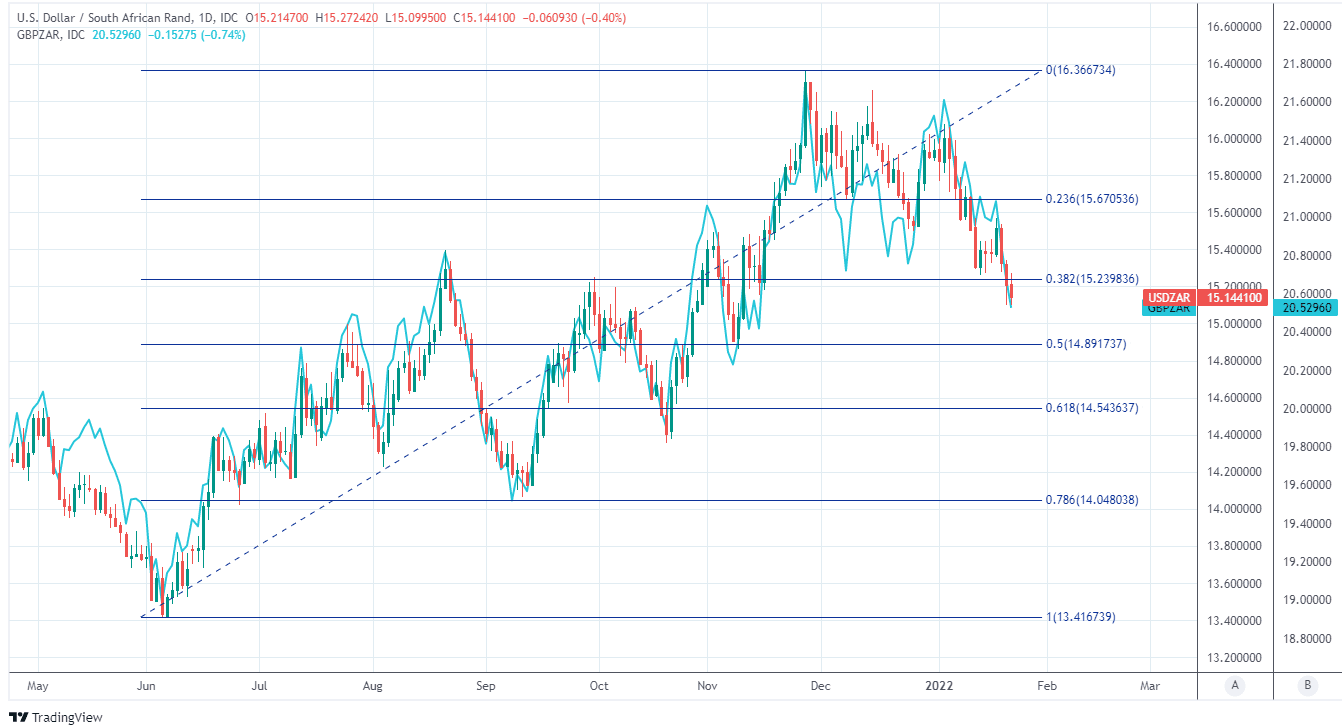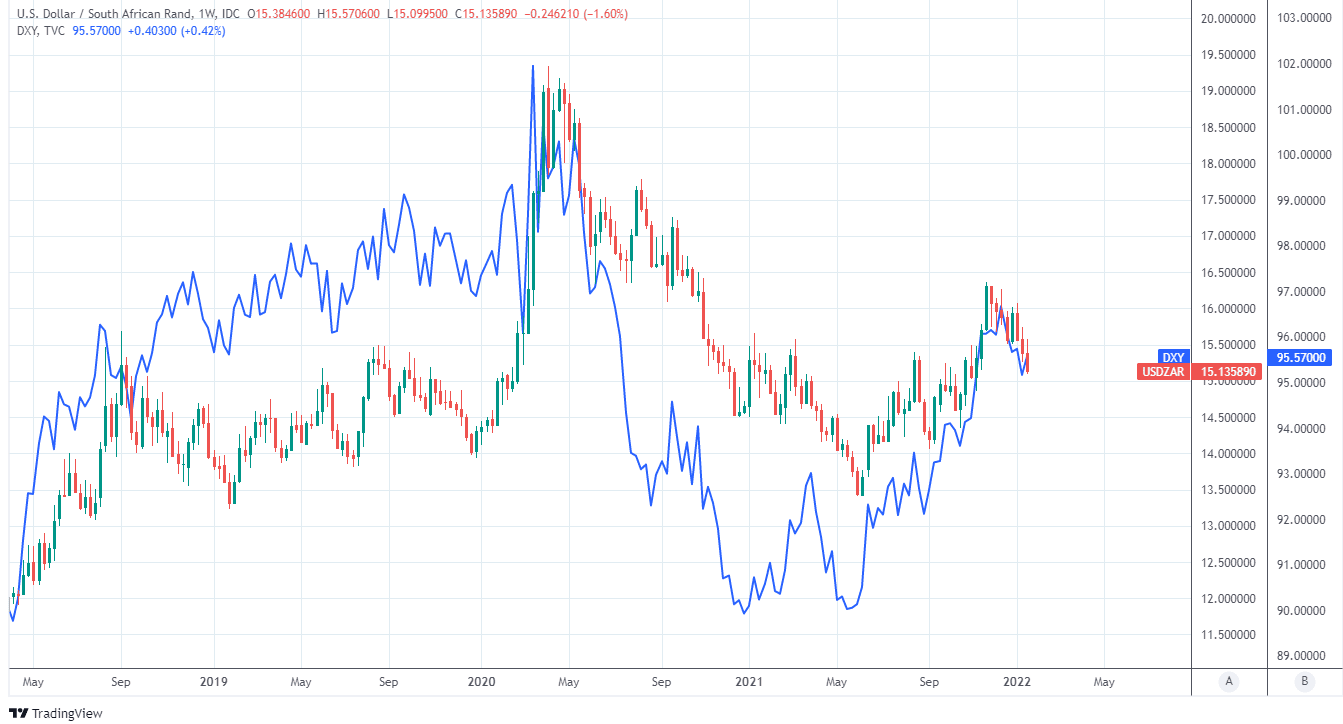Top Performing South African Rand Eyes SARB and Fed Decisions
- Written by: James Skinner
- USD/ZAR nearing 15.0 on Rand outperformance
- But draws sellers ahead of SARB & Fed decisions
- Fed seen moving faster in 2022 while SARB lags
- FX market disappointment risks lifting USD/ZAR

Image © Adobe Images
Strategists have told clients that looming central bank decisions and other factors could reverse the South African Rand's recent outperformance during the months ahead.
South Africa’s Rand built further on its 2022 lead over other G20 currencies last week in an extended outperformance that pushed the Pound to Rand exchange rate decisively below 21.0 and pulled USD/ZAR down to its lowest level since early November last year
The Rand outperformed other currencies on Friday even as non-U.S. stock markets fell in Europe and elsewhere, and as commodity price developments turned supportive of the South African currency with gold rising and oil benchmarks declining.
“The rand reached R15.11/USD today, continuing to gain as the pandemic’s fourth wave shows evidence of peaking in a number of key economies,” says Annabel Bishop, chief economist at Investec.
“Optimism has increased that omicron may signal the end of the pandemic by replacing previous severe variants and having a steadying presence on COVID-19. Risk-on sentiment saw the rand break through R15.20/USD, with the next key resistance level R15.00/USD,” Bishop also said.
Above: USD/ZAR shown at daily intervals with Fibonacci retracements of June uptrend indicating likely areas of technical support, and shown alongside GBP/ZAR.
- GBP/ZAR reference rates at publication:
Spot: 20.59 - High street bank rates (indicative): 19.88-20.03
- Payment specialist rates (indicative): 20.42-20.50
- Find out about specialist rates, here
- Set up an exchange rate alert, here
While many analysts cited a receding wave of coronavirus infections for the more upbeat mood in U.S. stock markets on Friday, the Rand itself may also have been helped over the course of the week by earlier reports suggesting President Cyril Ramaphosa is on the cusp of ending the South African state of emergency, which would bring an end to the remaining containment measures in effect in South Africa.
There is a potential rub for the Rand, however, which is that South African and U.S. central bank monetary policies are likely to be back in focus next week and could potentially crimp market appetite for the currency.
“We see only a gradual tightening cycle in South Africa with only 100bps tightening in 2022 (year-end policy rate at 4.75%). The market is pricing more than 200bps of tightening by the end of this year. Repricing of market expectations for policy rate tightening should also be bearish for the rand,” says David Hauner, head of EEMEA economics and FX strategy at BofA Global Research.
“Moreover, we also forecast a weakening of the terms of trade as we see metals (iron ore, gold) underperform vs energy prices. The risk to the trade would be a broad-based USD sell-off,” Hauner and colleagues said this week when recommending that clients bet on an increase in USD/ZAR.
{wbamp-hide start}
{wbamp-hide end}{wbamp-show start}{wbamp-show end}
BofA Global Research told clients last week that USD/ZAR could rise to 16.50 over the coming months, citing a range of factors including an expected increase in Federal Reserve interest rates that could match or even exceed those announced by the South African Reserve Bank (SARB) this year.
“We remain bearish on short-end US rates, flagging a risk of three hikes by July. The ZAR is the best liquid hedge, in our view, due to its high correlation with debt indices and EM FX, as well as its high foreign positioning in local bonds (11% weight vs 8.5% benchmark), even though FX positioning is already underweight,” Hauner wrote.
“Local fundamentals also look bearish: markets already price the maximum possible SARB hikes (too much, we think), and we forecast worsening terms of trade. Now is a good entry point as the retracement after the US CPI last week appears to have petered out, and the 14-day RSI indicator for USD/ZAR is approaching the oversold level,” Hauner and colleagues also said.
The SARB is set to announce its January interest rate decision on Thursday, a day following the latest update from the Federal Reserve.
The Fed signalled in December that U.S. borrowing costs could begin to rise as soon as March when the winding down of the bank’s pandemic-inspired quantitative easing programme has been completed.
Above: USD/ZAR shown at weekly intervals alongside U.S. Dollar Index.







